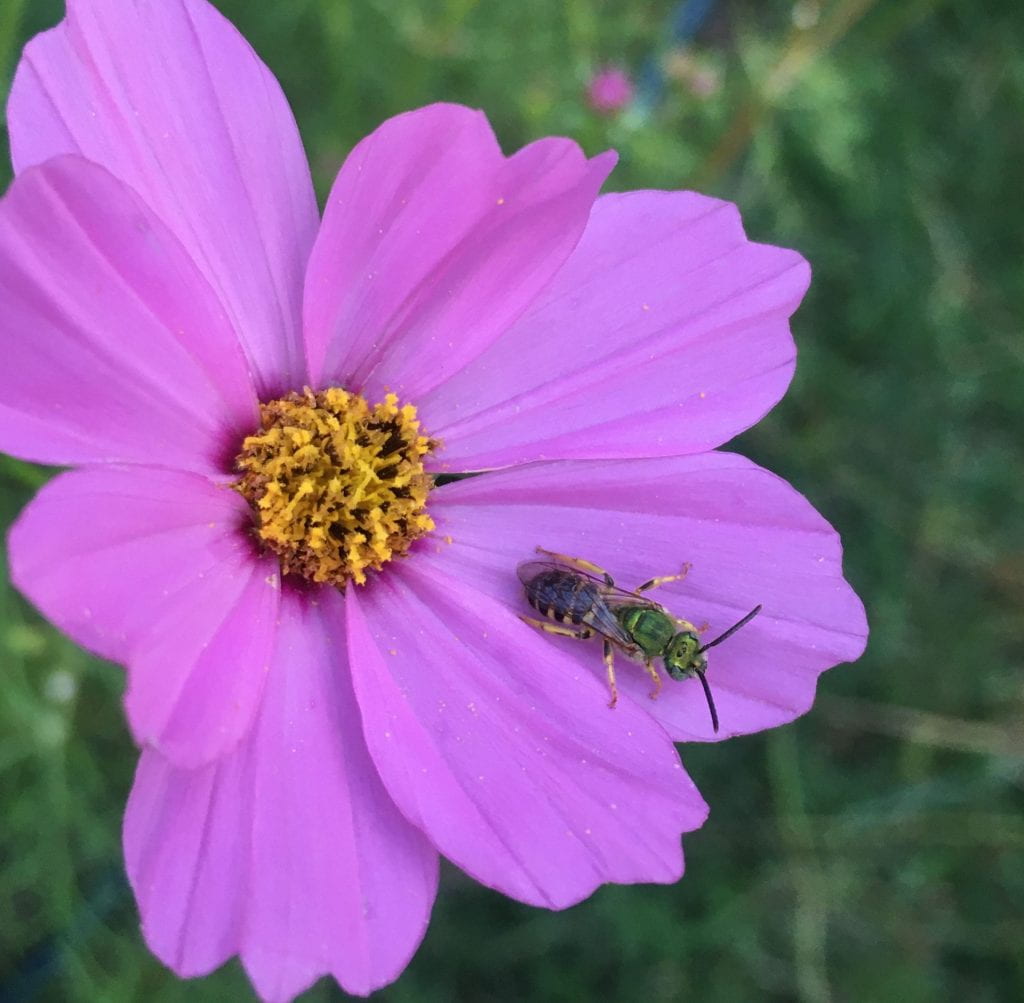The days are getting longer and (sometimes) warmer, trees are beginning to leaf out, spring bulbs are blooming, and lots of people are anxious to clean up their gardens. But you may have heard that cleaning up your garden too early is bad for pollinators and other beneficial insects like natural enemies of pests. Is this true? How long do you need to wait?

What’s the concern with early garden clean-up?
There are two aspects of garden clean-up that pose a risk to beneficial insects in your garden: cutting out dead stems and clearing away leaves or other debris on the ground. Some species of wild bees nest in dead stems, so cutting down and disposing of these stems before the bees emerge for the spring is problematic. Dead leaves and other plant debris on the ground provide shelter for natural enemies like lady beetles, fireflies, and ground beetles. Pristinely-raked garden beds remove this shelter. You can read more about the benefits of messiness in this ThinkIPM blog post.
When should I clean up my garden?
First, please don’t clean your garden up in the fall. With the exception of removing and disposing of diseased or insect-infested plants (especially annuals), let your garden rest in the fall.
Ok, so you’ve waited until spring. But when? It’s complicated. You are trying to protect a diverse group of wild bee species, who are nesting in diverse settings (including both the ground and dead plant stems), in addition to many different species of beetles, spiders, and other arthropod natural enemies of pests. It should come as no surprise that all of these different arthropods emerge from their winter homes at different times. For example, around here (NY) bumble bees, carpenter bees, mason bees, and mining bees emerge earlier (early April) than sweat bees (May). Even within two species of mason bee, researchers found that the temperature during the winter, the sex of the bees, and their size all significantly impacted when they would emerge in the spring (varying by up to 40 days). Winter temperatures also impact when alfalfa leaf cutting bees and other bees emerge.

So what should I do?
First, don’t let the complexity of the situation paralyze you. Can you leave just a part of your garden “messy” year round, while you clean up the flower bed right next to the street? Do it. Don’t let the perfect become the enemy of the good. You might also consider making or purchasing a sign that lets your neighbors know why you are keeping your garden a bit untidy. It could spark some interesting conversations, and maybe you’ll start a new trend!
Second – and related to the first suggestion – remember that diversity is a strength. No single way of gardening is good for all beneficial insects. For example, mulch provides shelter for beetles (many of which are predators), but ground nesting bees need bare ground. Different parts of your yard or garden can support different beneficial insects.
Third, the Xerces Society offers some guidelines for timing garden clean-up by watching the weather and what’s happening to other plants around you. However, this advice is specifically for protecting bees, and doesn’t address the needs of natural enemies of pests.
- In the northeast, don’t start garden clean-up until your taxes are submitted. But realize that even waiting until mid to late April is still too early for some bee species.
- The cool season grasses we usually have growing in our lawns generally require the soil to be about 50° F in order to start growing. Wait to clean up your gardens until you need to mow your lawn regularly. But always remember to mow high.
- Wait until apple and pear trees finish blooming. In the northeast U.S., apricots, peaches, plums, and cherries will bloom early (when many ground-nesting bees are emerging), but apples and pears won’t finish blooming until mid-May.
- To be extra safe, wait until you are ready to plant tomatoes (when night temperatures are consistently above 50° F). At least in my part of NY, this may not be until late May.
Fourth, if you feel like you absolutely can’t wait to do some garden clean-up, change how you dispose of the debris you remove. Cut back last-year’s dead stems and pile them loosely in a corner of your yard (rather than bagging them and taking or sending them to a compost facility). Insects that have yet to emerge from the stems can still do so. Once you’re well into summer, feel free to compost this debris. But remember that your landscaping choices can also create spaces for ticks to hang out.

Happy gardening!
This post was written by Amara Dunn, Biocontrol Specialist with the NYSIPM program. All images are hers, unless otherwise noted.